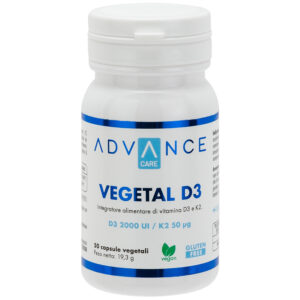Vitamin D
Vitamin D (calciferol) is a fundamental micronutrient for our health.
Specifically, vitamin D refers to a group of liposoluble pro-hormones consisting of five different molecules, of which the most important for our body are vitamin D3 (cholecalciferol) and vitamin D2 (ergocalciferol).
Vitamin D3 is synthesized in animal organisms and is present in a few food sources: liver, red meat, milk and derivatives, cod liver oil, fatty fish (i.e. salmon, herring, trout), egg yolk. Vitamin D2 is instead present in foods of vegetable origin, such as green leafy vegetables (spinach, herbs, chard) and mushrooms. Scientific evidence has clearly shown that the most effective and best absorbed oral form (most bioavailable) is vitamin D3 (Lehmann et al., J Clin Endocrinol Metab, 2013).
Although it is included among the vitamins, it actually acts as a hormone that regulates different functions of the body. The main role of vitamin D is to promote an optimal intestinal absorption of calcium contained in the food, and therefore it favors the correct mineralization of the skeleton. Noteworthy, this is not the only beneficial effects of vitamin D on the body. Several studies have further attributed to vitamin D an important role in the health of the cardiovascular system and in the prevention of cancer (Judd & Tangpricha, Am J Med Sci, 2009; Grant, Cancer, 2002).
Vitamin D is also implicated in the strengthening of the immune system and it is also for this reason that in the winter months, when its concentration in plasma is low, we tend to get sick more.
Unlike other vitamins, vitamin D3 derives only partially from the diet. In fact, the body is able to synthesize it autonomously with the sole exposure of the skin to sunlight. Once produced, vitamin D is stored in the adipose tissue which can release it if necessary. The quantity produced endogenously depends on various factors, such as the period of the year (there is less sun in the winter months), the time of the day (the sun’s rays are more effective between 10.00 and 15.00), the quantity of cloud cover, the atmospheric pollution, the latitude (cities near the equator are exposed to higher levels of UV rays).
These factors can lower the concentration of 25-hydroxycholecalciferol (the pro-active form of vitamin D3) in the blood from the from the optimal threshold (50-60 ng/mL) toward a deficiency state called hypovitaminosis D, in which the concentration in the blood it is found on values below 20-30 ng/mL. This state of hypovitaminosis has a series of negative effects that compromise bone mineralization and therefore lead to a greater risk of developing osteoporosis in adult individuals, as well as many other series of disorders.
It is usually suggested to assume from the diet 15 µg vitamin D per day for both sexes. However, hypovitaminosis D is more frequent in women, as part of vitamin D is produced by testis (if there are not some kind of pathologies, for example obesity). It should also be noted that there are some conditions in which the need for vitamin D increases and, therefore, an supplemention should be considered. To cite some examples: in pregnancy there is an increased demand for the normal development of the embryo in the early stages of gestation; during menopause there is a reduction in calcium concentrations in the bones with consequent osteoporosis; in the elderly subjects the efficiency of vitamin D skin synthesis decreases (like solar panels that lose their efficiency in absorbing sunlight); in diabetic subjects (Cesareo et al., Nutrients, 2018).
In athletes, vitamin D deficiency often occurs and can potentially affect training efficiency as well as health. The type of discipline can be a determining factor: for example an indoor training does not allow sufficient sunlight exposure for vitamin D synthesis.
Since vitamin D intervenes in many metabolic pathways, it is very important that the athletes consider the possibility of supplementation in order to ensure its adequate availability and storage and, thus, optimal performance. Studies have shown that the maintenance of an adequate blood value of vitamin D can reduce stress fractures, inflammation, infectious diseases and helps the recovery of impaired muscle function after an injury (Larson-Meyer, Nutritional Coaching Strategy to Modulate Training Efficiency, 2013). Vitamin D status is also positively associated with muscle strength (increase in size and quantity of fast-twitch muscle fibers) and physical performance, providing an improvement in performance, especially in those times of the year when it is not present at the highest levels in the blood (summer and autumn).
+Watt Advice
Recommended use: dissolve 10 drops of D3+ mixed with a beverage or consumed directly from the dropper.


